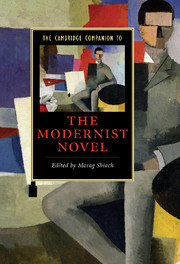Book contents
- Frontmatter
- Reading the modernist novel: an Introduction
- 1 Modernists on the art of fiction
- 2 Early modernism
- 3 Remembrance and tense past
- 4 Consciousness as a stream
- 5 The legacies of modernism
- KEY NOVELISTS
- 6 James Joyce and the languages of modernism
- 7 Tradition and revelation: moments of being in Virginia Woolf’s major novels
- 8 Wyndham Lewis and modernist satire
- 9 D. H. Lawrence: organicism and the modernist novel
- 10 Joseph Conrad’s half-written fictions
- 11 Djuna Barnes: melancholic modernism
- 12 William Faulkner: an impossibly comprehensive expressivity
- 13 Writing lives: Dorothy Richardson, May Sinclair, Gertrude Stein
- 14 C. L. R. James, Claude McKay, Nella Larsen, Jean Toomer the ‘black Atlantic’ and the modernist novel
- 15 Situating Samuel Beckett
- Further reading
- Index
15 - Situating Samuel Beckett
from KEY NOVELISTS
Published online by Cambridge University Press: 28 July 2007
- Frontmatter
- Reading the modernist novel: an Introduction
- 1 Modernists on the art of fiction
- 2 Early modernism
- 3 Remembrance and tense past
- 4 Consciousness as a stream
- 5 The legacies of modernism
- KEY NOVELISTS
- 6 James Joyce and the languages of modernism
- 7 Tradition and revelation: moments of being in Virginia Woolf’s major novels
- 8 Wyndham Lewis and modernist satire
- 9 D. H. Lawrence: organicism and the modernist novel
- 10 Joseph Conrad’s half-written fictions
- 11 Djuna Barnes: melancholic modernism
- 12 William Faulkner: an impossibly comprehensive expressivity
- 13 Writing lives: Dorothy Richardson, May Sinclair, Gertrude Stein
- 14 C. L. R. James, Claude McKay, Nella Larsen, Jean Toomer the ‘black Atlantic’ and the modernist novel
- 15 Situating Samuel Beckett
- Further reading
- Index
Summary
However astute Friedrich Nietzsche’s observation that 'the big problems [are] like cold baths; you have to get out as fast as you [get] in', one would be ill advised to withdraw too rapidly from the 'big problem' of modernism. There is much to be gained, as we have seen in the preceding chapters, by framing the fiction of a given author in accordance with the historical, stylistic and thematic parameters of the modernist aesthetic. Yet just where a writer as slippery as Samuel Beckett (1906-1989) lies on the spectrum that extends from early to late, from low to high and then post, has prompted considerable debate in recent years. It will not be the purpose of this chapter to enter that debate, but rather to suggest a means of access into Beckett’s novels that will reveal the essence of their link to modernism, regardless of the prefix one assigns to the term.
We might begin by noting that Beckett’s fiction clearly exhibits the oppositional spirit fundamental to the modernist enterprise. In fact, his experimentation with novelistic form reveals an opposition to the conventional rules of narration so extraordinary that when he began writing novels it provoked a veritable crisis of genre. That is to say, the congruence of form and content - such as is found in the dissolution, at once, of any coherent storytelling and of any real character identity - threw into question the very nature of the novel itself. Already in his 1931 essay Proust, which appeared in print several years before his first novel, one perceived the preoccupation with the recovering of lost selves in which the primary tension of his own novelistic concerns would originate. If reality in Proust’s masterwork depended upon the projection of an individual’s subjective awareness and, at the same time, every individual was revealed to be a succession of individuals, reality maintained nonetheless a veneer of constancy.
- Type
- Chapter
- Information
- The Cambridge Companion to the Modernist Novel , pp. 224 - 237Publisher: Cambridge University PressPrint publication year: 2007

